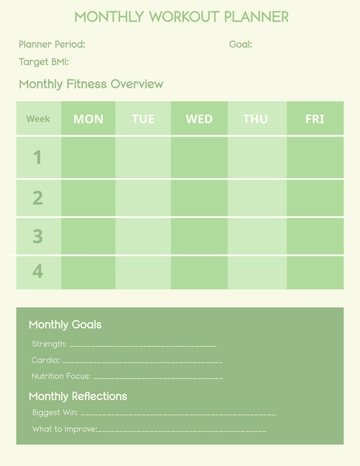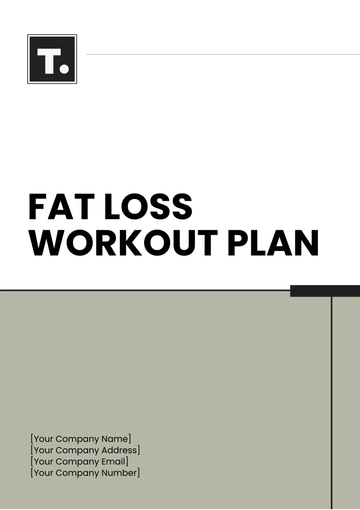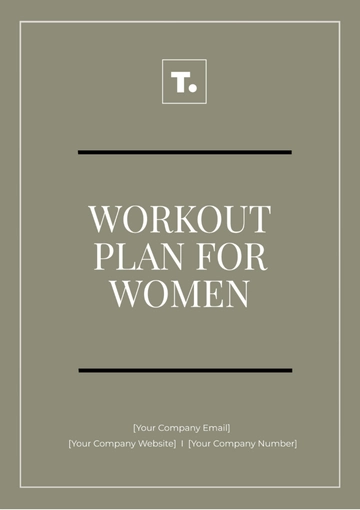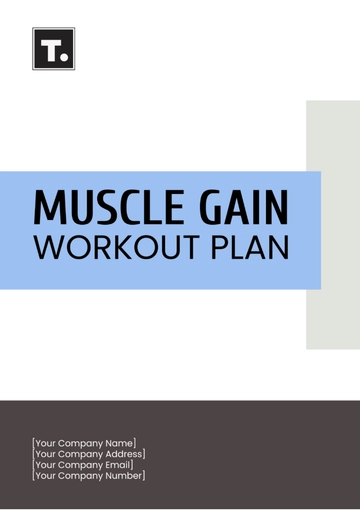Free Gym Workout Plan

I. Introduction:
Welcome to the [YOUR COMPANY NAME]'s Gym Workout Plan designed to help [YOUR NAME] track your progress and achieve your fitness goals effectively. This plan is tailored to assist you in monitoring your strength, endurance, and overall fitness improvements over time.
II. Initial Assessment:
Before starting the workout plan, it's essential to conduct an initial assessment to establish baseline measurements. This assessment may include:
Assessment Type | Measurements |
|---|---|
Body Measurements | Weight, Body Fat Percentage, Chest, Waist, Hips, Arms, Thighs |
Fitness Tests | Push-ups, Sit-ups, Flexibility (e.g., sit-and-reach test) |
Strength Assessment | One-Rep Max for Key Lifts (e.g., Bench Press, Squat, Deadlift) |
It's recommended to perform the initial assessment under the guidance of a qualified fitness professional to ensure accuracy and safety. Record the baseline measurements in a journal or digital tracker to track progress over time.
III. Goal Setting:
Based on the initial assessment, set specific, measurable, achievable, relevant, and time-bound (SMART) fitness goals. Examples include:
Fitness Goal | Target | Timeline |
|---|---|---|
Increase Muscle Mass | Aim to increase muscle mass by 10% over the next 6 months through progressive resistance training and optimal nutrition. | 6 Months |
Reduce Body Fat | Aim to reduce body fat percentage by 5% in the next 3 months through a combination of calorie deficit, cardiovascular exercise, and strength training. | 3 Months |
Improve Strength | Aim to increase one-rep max for key lifts (e.g., Bench Press, Squat, Deadlift) by 20 lbs within the next 4 months by following a structured strength training program with progressive overload. | 4 Months |
Ensure that your goals are realistic, challenging, and aligned with your long-term aspirations. Break down larger goals into smaller milestones to track progress more effectively.
IV. Workout Plan:
Day 1: Upper Body
Warm-up: 5 minutes of jogging on the treadmill or dynamic warm-up exercises targeting the upper body.
Strength Training:
Exercise | Sets x Reps |
|---|---|
Bench Press | 3 x 8-10 |
Bent-over Rows | 3 x 8-10 |
Shoulder Press | 3 x 8-10 |
Accessory Work:
Exercise | Sets x Reps |
|---|---|
Bicep Curls | 3 x 10-12 |
Tricep Dips | 3 x 10-12 |
Cool-down: Stretching for 10 minutes focusing on the chest, back, shoulders, biceps, and triceps.
Day 2: Lower Body
Warm-up: 5 minutes of cycling on the stationary bike or dynamic warm-up exercises targeting the lower body.
Strength Training:
Exercise | Sets x Reps |
|---|---|
Squats | 3 x 8-10 |
Deadlifts | 3 x 8-10 |
Lunges | 3 x 8-10 (each leg) |
Accessory Work:
Exercise | Sets x Reps |
|---|---|
Calf Raises | 3 x 12-15 |
Leg Press | 3 x 10-12 |
Cool-down: Foam rolling for 10 minutes focusing on the quadriceps, hamstrings, glutes, and calves.
Day 3: Rest or Active Recovery
V. Progress Tracking:
Regularly track your progress to monitor the effectiveness of your workout plan and make adjustments as needed. Here are some strategies for progress tracking:
Workout Logs: Keep detailed records of your workouts, including exercises performed, sets, reps, weights lifted, and rest periods. This allows you to track strength gains and identify areas for improvement.
Body Measurements: Take regular body measurements (e.g., weight, body fat percentage, waist circumference) to monitor changes in body composition over time.
Fitness Assessments: Periodically reassess your fitness level by repeating the initial assessments, such as fitness tests and strength assessments. Compare the results with baseline measurements to gauge progress.
Visual Progress: Take progress photos at regular intervals to visually track changes in muscle definition, body composition, and overall physique.
Feedback and Reflection: Reflect on your workouts, nutrition, and recovery practices regularly. Use feedback from your own observations and input from fitness professionals to refine your approach and stay on track toward your goals.
VI. Nutrition and Recovery:
Proper nutrition and recovery are essential components of any effective workout plan. Here are some key considerations:
Nutrition:
Fuel your body with a balanced diet rich in:
Lean proteins
Complex carbohydrates
Healthy fats
Fruits and vegetables
Stay hydrated by drinking water throughout the day.
Consider incorporating supplements if needed to fill nutritional gaps.
Post-Workout Nutrition:
Consume a balanced meal or snack within 30-60 minutes after your workout.
Aim for a combination of carbohydrates and protein to replenish glycogen stores and promote muscle recovery.
Examples include:
Protein shake
Chicken and vegetable stir-fry
Turkey sandwich on whole-grain bread
Rest and Recovery:
Allow sufficient time for rest and recovery between workouts to prevent overtraining and reduce the risk of injury.
Aim for 7-9 hours of quality sleep per night to support muscle repair and growth.
Incorporate active recovery activities such as:
Yoga
Foam rolling
Leisurely walks on rest days
Stress Management:
Practice relaxation techniques such as:
Deep breathing
Meditation
Mindfulness
Manage stress levels to promote mental and emotional well-being, which can positively impact physical recovery and progress towards fitness goals.
By prioritizing proper nutrition and recovery practices, you can maximize the benefits of your workouts and accelerate progress toward your fitness goals. Remember that consistency and patience are key, and don't hesitate to seek guidance from a registered dietitian or certified nutrition coach if needed.
VII. Conclusion:
Stay committed to the Gym Workout Plan and make adjustments as needed based on progress and feedback. Remember that consistency and patience are key to achieving your fitness goals.
Keep pushing yourself towards your fitness goals and enjoy the journey!
- 100% Customizable, free editor
- Access 1 Million+ Templates, photo’s & graphics
- Download or share as a template
- Click and replace photos, graphics, text, backgrounds
- Resize, crop, AI write & more
- Access advanced editor
Maximize your fitness goals with the Gym Workout Plan Template from Template.net. This customizable and editable template is designed for all fitness levels. With the AI Editor Tool, you can personalize your workout plans effortlessly. Achieve better results by organizing your routines and tracking progress. Start your fitness journey today.
You may also like
- Finance Plan
- Construction Plan
- Sales Plan
- Development Plan
- Career Plan
- Budget Plan
- HR Plan
- Education Plan
- Transition Plan
- Work Plan
- Training Plan
- Communication Plan
- Operation Plan
- Health And Safety Plan
- Strategy Plan
- Professional Development Plan
- Advertising Plan
- Risk Management Plan
- Restaurant Plan
- School Plan
- Nursing Home Patient Care Plan
- Nursing Care Plan
- Plan Event
- Startup Plan
- Social Media Plan
- Staffing Plan
- Annual Plan
- Content Plan
- Payment Plan
- Implementation Plan
- Hotel Plan
- Workout Plan
- Accounting Plan
- Campaign Plan
- Essay Plan
- 30 60 90 Day Plan
- Research Plan
- Recruitment Plan
- 90 Day Plan
- Quarterly Plan
- Emergency Plan
- 5 Year Plan
- Gym Plan
- Personal Plan
- IT and Software Plan
- Treatment Plan
- Real Estate Plan
- Law Firm Plan
- Healthcare Plan
- Improvement Plan
- Media Plan
- 5 Year Business Plan
- Learning Plan
- Marketing Campaign Plan
- Travel Agency Plan
- Cleaning Services Plan
- Interior Design Plan
- Performance Plan
- PR Plan
- Birth Plan
- Life Plan
- SEO Plan
- Disaster Recovery Plan
- Continuity Plan
- Launch Plan
- Legal Plan
- Behavior Plan
- Performance Improvement Plan
- Salon Plan
- Security Plan
- Security Management Plan
- Employee Development Plan
- Quality Plan
- Service Improvement Plan
- Growth Plan
- Incident Response Plan
- Basketball Plan
- Emergency Action Plan
- Product Launch Plan
- Spa Plan
- Employee Training Plan
- Data Analysis Plan
- Employee Action Plan
- Territory Plan
- Audit Plan
- Classroom Plan
- Activity Plan
- Parenting Plan
- Care Plan
- Project Execution Plan
- Exercise Plan
- Internship Plan
- Software Development Plan
- Continuous Improvement Plan
- Leave Plan
- 90 Day Sales Plan
- Advertising Agency Plan
- Employee Transition Plan
- Smart Action Plan
- Workplace Safety Plan
- Behavior Change Plan
- Contingency Plan
- Continuity of Operations Plan
- Health Plan
- Quality Control Plan
- Self Plan
- Sports Development Plan
- Change Management Plan
- Ecommerce Plan
- Personal Financial Plan
- Process Improvement Plan
- 30-60-90 Day Sales Plan
- Crisis Management Plan
- Engagement Plan
- Execution Plan
- Pandemic Plan
- Quality Assurance Plan
- Service Continuity Plan
- Agile Project Plan
- Fundraising Plan
- Job Transition Plan
- Asset Maintenance Plan
- Maintenance Plan
- Software Test Plan
- Staff Training and Development Plan
- 3 Year Plan
- Brand Activation Plan
- Release Plan
- Resource Plan
- Risk Mitigation Plan
- Teacher Plan
- 30 60 90 Day Plan for New Manager
- Food Safety Plan
- Food Truck Plan
- Hiring Plan
- Quality Management Plan
- Wellness Plan
- Behavior Intervention Plan
- Bonus Plan
- Investment Plan
- Maternity Leave Plan
- Pandemic Response Plan
- Succession Planning
- Coaching Plan
- Configuration Management Plan
- Remote Work Plan
- Self Care Plan
- Teaching Plan
- 100-Day Plan
- HACCP Plan
- Student Plan
- Sustainability Plan
- 30 60 90 Day Plan for Interview
- Access Plan
- Site Specific Safety Plan





























